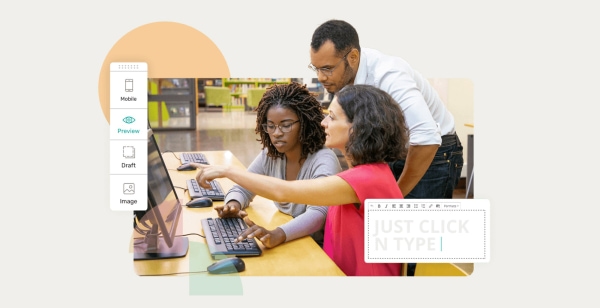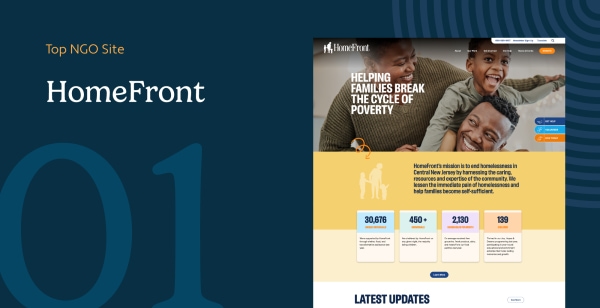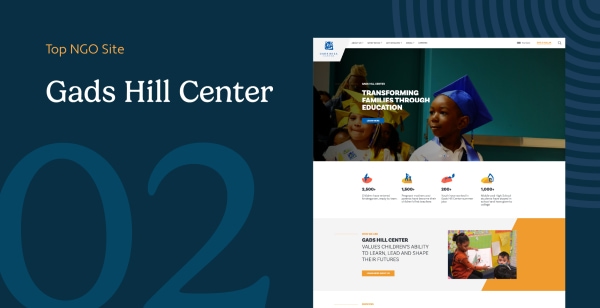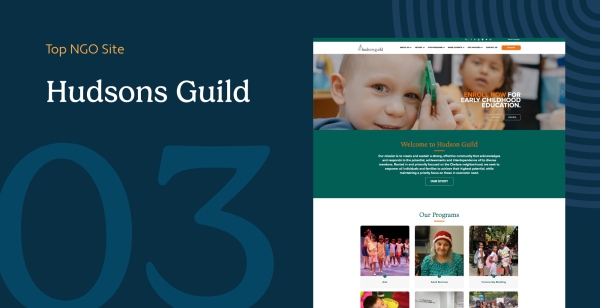NGO Website Development: How to Make Your Site a Success


Want an engaging website?
A thoughtfully created non-governmental organization (NGO) website increases the legitimacy of your organization, helps supporters better understand your cause, and solidifies your professionalism when soliciting support. With more than 1.8 million nonprofits in the U.S. (as of 2024) and nearly 136,000 in Canada, a strong web presence is critical to make your mission stand out. As a result, a great website will better position you to push forward your mission and reach more people.
To maximize these benefits, we’ll walk you through the best practices and web design tools you need to revamp your digital presence. Since most NGOs have limited budgets, a well-designed website is a cost-effective and efficient way to spread your cause beyond local advocates and increase your support. Let’s get started!

How can I make an NGO website?
Thanks to modern technology, creating a website is becoming easier and easier. You no longer need a developer to set up a basic site because there are several easy-to-use website builders that you can use to simplify the process. By getting your NGO (or nonprofit) website up and running promptly, you’ll increase visibility and further your mission.
Before launching your site, you’ll need to complete a few steps:
The three key steps to building an NGO website are: evaluating your goals, choosing a website builder, and starting the design process.
1. Evaluate your organization’s goals.
First, identify your intended audience and the goals you wish to reach with your NGO website. Pick the design elements that are most relevant to your organization and its goals. For instance, if your online objective is to secure donations, your website should clearly explain your need for funding and how the donations will be spent.
On the other hand, if your website’s purpose is to connect with people who need help—families who can’t afford food, for example—include instructions for applying for federal food aid or post a map indicating local food banks. Depending on your focus, figure out how to integrate and apply these elements to your organization’s web design. This way, you know exactly which pages and information to include, as well as which elements to emphasize when creating your layout.
2. Select a website builder.
Now it’s time for the most important step: choosing a content management system (CMS). Don’t just settle for any CMS. Do your research and compare your options. That way, you’ll invest in a comprehensive solution that suits your organization and offers the features you need—such as form builders and event ticketing. Above all else, it should be functional and easy to use.
If your website builder offers templates, select one to simplify the design stage and get your website up and running with ease. You’ll find that some builders have pre-set designs, while others provide you with more creative flexibility (for example, the ability to choose from different gallery sliders and menu styles). Once you’ve chosen a good fit, start designing! For some inspiration, check out our tips for creating a beautiful nonprofit website design.

3. Start the website-building process.
At this point, you can begin the website-building process in earnest. This process can take several months and has many steps within itself. For example, some of the things you’ll need to decide include:
- What the site directory will look like
- How the site will flow
- Which pages you want to create and the purpose they’ll serve
- Which elements you want on each page
- The specific visual elements and text on each page
- What pages should be featured in the navigation header
Start the process by putting together a website plan that includes all this information and anything else you’ll need to keep in mind. As you do so, focus on thinking through what should be on each page and how users will navigate to reach their goal destination.
Building a website plan can be a daunting task if you’re unfamiliar with the process. That’s where web design companies come into play—these organizations are dedicated to helping you create the website of your dreams. For example, Morweb offers an easy-to-use CMS for nonprofits and NGOs of all sizes—no technical knowledge necessary! We help organizations achieve the greatest fulfillment of their vision online so they can build meaningful connections with users and grow their impact.
What should my NGO website contain?
An effective website looks different for every NGO, which can make it difficult to choose what to include on your site. While it ultimately depends on your NGO’s specific goals, there are a few common pages that any NGO should include:
Key pages and sections your NGO website should contain, including a donation page, events page, members-only area, an updated blog, and social sharing options.
Donation Page
Funds are essential to continue striving toward your mission. While membership dues might make up the majority of your funds, donations can produce additional revenue for your NGO. Because of this, you’ll want to feature a well-designed donation page instead of solely relying on direct mail and in-person gifts.
Arguably the most crucial part of this page is your built-in donation form, which tends to drive more donations than externally linked forms. Select a CMS that comes with an intuitive form builder and secure payment integration for collecting donations online to create a streamlined donation process for your NGO. Plus, make sure that it can accommodate the various donation types you accept, such as matching gifts or recurring gifts. (It’s estimated that $6–10 billion in matching gift funds go unclaimed every year, largely due to lack of awareness —so highlighting corporate matching on your donation page can help address this.)
Follow best practices when creating forms, such as limiting the number of input fields to keep the process quick. After all, once someone feels motivated to donate, you don’t want anything to slow them down. Your CMS should come with everything you need to create a seamless donation experience that supporters can complete in just moments. And remember, online giving continues to grow, with online donations expected to climb about 13% annually through 2025—making an optimized donation page more important than ever.
Events Page
As an NGO practitioner, you may be accustomed to raising funds through membership dues, proposal writing, corporate partnerships, and direct calls. However, special events can take your fundraising strategy to the next level. With an easily accessible events page, members and donors will know exactly how they can stay involved with your NGO.
To create your events page, ensure your CMS offers registration and ticketing capabilities. It should also allow you to feature elements like:
- A header image
- Date and time
- Description
- Register button
- Built-in registration form
These design elements make your events page much more engaging than a generic calendar. Remember to add your events page to the main navigation menu, so users know exactly where it is the moment they land on your homepage.
Members-Only Area
As an NGO, a substantial portion of your revenue likely comes from your membership program. Members-only areas serve as a great incentive for joining your organization, allowing you to attract and retain valuable supporters. Prioritize the member experience by featuring these members-only areas on your website:
- Educational resources: Provide members with high-quality resources, including articles, podcasts, and webinars.
- Members-only events: Show members the value of their membership by inviting them to exclusive events. (If these are virtual or hybrid events, include the event link directly in the members-only area.)
- Forum: A discussion forum allows members to interact with each other, enabling them to discuss recent events, industry trends, and personal experiences. Plus, your team will have an easy outlet for quickly announcing updates and answering member questions.
- Member map: An interactive map or directory is a great engagement tool. Sort and categorize members so they can easily search for others to connect with. Make sure it’s mobile-friendly, too, so users can access it on the go!
With members-only areas, NGOs can establish a sense of community and demonstrate the value they bring to their members. This boosts member satisfaction and retention. Soon enough, the word will spread about the positive culture your NGO has instilled. Just be sure your CMS allows you to manage user permissions so that you can privatize any members-only pages and fully leverage these benefits.
Updated Blog
Fuel your NGO’s growth by putting industry knowledge at readers’ fingertips. A blog is a great way to accomplish this, providing you with an outlet to share educational content and powerful stories that evoke emotion in readers. Determine what goal you’d like your blog to accomplish, then develop content that communicates your vision and pushes you along that path.
For instance, if your goal is to persuade public officials to make a policy change, you might focus on addressing specific policies and starting a conversation among readers. Whether you feature industry insights or updates on your NGO, take extra time to develop valuable posts. You’ll bring in more members and keep them involved with high-value content that demonstrates your expertise.
Social Sharing Options
Your online engagement strategy may start with your NGO website, but it certainly doesn’t end there. To fully extend your reach, expand your marketing to social media by featuring social sharing buttons on your site.
Links to your social media accounts allow you to connect with prospects and donors through those channels. When visitors feel compelled to share your insightful blog posts or exciting events online, convenient social sharing options enable them to do so with a single click. By making it easy, supporters will be much more likely to pass along your message to friends and family on their favorite platforms.

Tools for Building Essential NGO Website Pages
Now that you know the pages and elements your NGO website should contain, let’s take a look at a few helpful tools for actually building out your site.
Morweb
Choosing the right CMS is crucial to ensuring that your website-building process is smooth and uncomplicated. Luckily, Morweb offers just that with its host of helpful features:
- Drag-and-drop editor: Editing content and page layouts is simple with Morweb—our intuitive drag-and-drop editor allows you to adjust on-page elements without any coding. Plus, it’s convenient to make changes in the future so your website stays fresh and up-to-date.
- Optimized images: Once you upload images to Morweb and add them to your page, they’ll automatically be optimized in size and dimension. This ensures quick load times and visually appealing images for all viewers, regardless of screen size.
- Mobile responsiveness: Morweb will automatically optimize all of your on-page elements so they look crisp across all screen sizes. Plus, you can use the mobile preview toggle to see your website as it appears on smaller screens, ensuring simple navigation and a positive user experience on phones and tablets.
- Social media integrations: Allow web visitors to share any page, post, or image from your website directly to social platforms like Facebook and LinkedIn. You’ll also be able to embed your social media feeds on your site to show off recent activity and gain more followers.
- Accessibility features: Stay compliant with accessibility standards using Morweb’s built-in accessibility tools, including ALT tags, descriptions, custom URLs, and more. You can even embed an accessibility widget that allows web users to adjust font size or colors and highlight links to create a web experience customized to their needs.
- Analytics and SEO tools: Stay in the know on visitor engagement and whether your website is trending in the right direction with Morweb’s integration with Google Analytics. This displays vital metrics for your NGO website, pulled from Google Analytics in real-time. Plus, make adjustments to your strategy with our built-in SEO tools (like meta tag editors and sitemap generation).
With Morweb CMS’s features, you’ll be well-equipped to create the NGO website of your dreams. In fact, designing a beautiful NGO website is possible for everyone with Morweb’s nonprofit-specific platform. We know what it takes for organizations like yours to succeed online, and our team is ready to support you through every step of the web design process.
Double the Donation
Aside from membership dues and other fees, your NGO likely relies on donations for a significant portion of your revenue. Since these funds are essential for you to fulfill your mission, maximizing donations should be a top priority. One of the best ways to do so is through matching gifts.
This is how the matching gift process usually works:
- An individual donates to your NGO.
- The donor fills out a matching gift request and submits it to their employer.
- The employer verifies the donation and determines if your NGO is eligible for a match.
- The employer issues a matching gift to your organization.
Although this process is straightforward, it relies on the donor being aware of matching gifts and being willing to put in the effort to submit the request. Unfortunately, awareness is a huge issue—it’s estimated that between $4–$7 billion in corporate matching gift funds go unclaimed every year. That’s where Double the Donation comes in. With its matching gifts solution, 360MatchPro, you can prompt donors to check their matching gift eligibility during and after the donation process, effectively doubling (or even tripling) the donations you receive without asking supporters to contribute more out-of-pocket.
Using Double the Donation’s tools, you’ll save staff time by automating gift-matching outreach and gain access to a vast database of companies with matching gift programs. Plus, with features such as auto-submission, you can streamline the matching gift process even further by allowing donors to initiate matches directly through your website. This ensures you capture every possible matching gift opportunity.
Kwala
To help your NGO website stand out from the crowd, be sure to incorporate appealing visual elements throughout it. In addition to core branding elements like your organization’s logo, this also includes custom images and graphics that engage the viewer. However, creating high-quality visuals can be challenging if you lack graphic design experience.
Kwala is a great resource for any NGO professional looking to spruce up their website with eye-catching visuals. This design agency offers unlimited graphic design services for a fixed monthly price, helping you create professional images with unlimited revisions. You can request anything from custom illustrations to infographics to icons, then upload these to your website to provide an engaging experience for all visitors. Plus, Kwala’s services aren’t limited to your website — they can design flyers, t-shirt graphics, stickers, postcards, and more to support your marketing efforts across the board.
NGO Website Design Best Practices
With over 1.8 million nonprofits in the U.S. (and many thousands more in Canada), it’s important to make yours stand out. A poorly designed or unstructured website will turn users away, causing you to miss out on crucial support that you could have otherwise secured. To avoid a negative user experience, let’s dive into a few best practices for effective NGO and nonprofit website development and design.
Feature a Mobile Responsive Design
These days, most users browse the web on their mobile devices. In fact, over half (52%) of nonprofit website traffic now comes from mobile devices. In other words, if you’re not using a mobile-responsive design, you’re likely missing out on a considerable number of potential supporters.
Mobile responsiveness means that the content on your website automatically adjusts to fit any screen size. Whether users are visiting your site on a desktop, tablet, or smartphone, they should be able to view your pages without constantly zooming or scrolling horizontally. Otherwise, navigating your NGO website will be difficult for mobile users, ultimately leading to frustration and causing them to leave your site altogether.
To easily optimize content for all devices, make sure your CMS features automatic mobile responsiveness so your team doesn’t have to tweak each element manually. This will ensure a smooth experience for both desktop and mobile visitors.

Optimize for Search Engines
When people search online for your NGO or the issue you address, how easily can they find your website? Are your blog posts ranking for the search terms you want them to? If not, it’s time to work on your search engine optimization (SEO).
SEO involves optimizing your NGO website’s content to help it rank prominently on popular search engines like Google. Search engines remain a major traffic source—one study found that 44% of nonprofit website visits came from organic search. To improve your visibility, use a CMS that offers built-in SEO tools. Specifically, keep an eye out for features like meta title and description editors, customizable URLs, automatic sitemaps, and schema markup. These tools will help you implement SEO best practices on each page so you can rank higher and drive more traffic to your NGO website.
If your NGO is also a registered nonprofit charity, make the most of your SEO efforts by applying for the Google Ad Grant. Through this program, Google provides eligible nonprofits with $10,000 USD in search ad credits every month, allowing you to greatly boost your website’s visibility on Google without tapping into your budget. Take a look at a hypothetical example of how your nonprofit’s website could appear at the top of a Google search results page when leveraging the Ad Grant. Unlike many other grants, any nonprofit that meets the program’s requirements will be approved for Google Ad Grants. If you’re already engaging in SEO for your NGO website, you’ll be well on your way to maximizing this ad credit and increasing your site’s visibility. (And if you’d like extra help with strategy, you might consider working with a Google Grants agency or consultant.)
Use White Space
Overloading your pages with text and images can distract users from your core messaging. To make your content easy to digest, incorporate plenty of white space in your design.
White space (the empty space between elements on a page) is a useful design tool that breaks up text and makes web pages more visually appealing and less overwhelming. Strategic use of white space allows users to focus on your most important content. For the best design, you’ll need to strike a balance between content and the space around it.
If you’re not sure where to start, Morweb offers customizable templates that feature an effective balance of content and white space. Using a well-designed template can speed up the design process and ensure you’re using white space effectively to guide the eye to key information.
Include Engaging Imagery
Motivate users to support your cause by featuring compelling images and even videos. Powerful visuals will draw prospects to your NGO website and keep them engaged as they navigate from page to page. Humans are visual by nature, and original imagery can often communicate emotion and impact better than text alone.
However, you’ll need to go above and beyond generic stock photos by featuring your own high-quality images. These could include photos of your team in action, your beneficiaries, volunteers, or the communities you serve. Using this type of authentic imagery enables you to illustrate the importance of your mission and build strong emotional connections with potential supporters. Whenever possible, invest in a good photographer (or train a staff member) to capture your events and programs. Then, showcase those pictures throughout your site to inspire visitors.
If video is within your capabilities, consider adding a short welcome video or mission summary on your homepage, or video testimonials from those you’ve helped. These dynamic elements can further increase engagement and persuade visitors to get involved.
Follow Web Accessibility Guidelines
When it comes to NGO websites, you want as many people as possible to view and interact with your content. That means you’ll need to adhere to web content accessibility guidelines (WCAG) so that people with disabilities or impairments can use your site without barriers. Start by implementing the following accessibility best practices in your design:
- High-contrast colors: High-contrast color schemes make it easier for visually-impaired users to see and read your content. The WCAG 2.1 guidelines recommend a minimum contrast ratio of 4.5:1 for text, so be sure to test the contrast of your font colors against your background colors. Adjust your design palette if needed to meet this standard for all text and graphics.
- Alternatives for multimedia: Visitors with hearing or visual impairments may struggle to consume videos and audio content without some help. Always provide a written transcript or closed captions for videos so those with hearing difficulties can read along. For users with visual impairments, consider adding audio descriptions that narrate important visual information in your videos. Similarly, provide ALT text for images so screen readers can describe them to blind users.
- Clear headings and structure: Use descriptive headings and subheadings to organize your content. This makes it easier for users with visual disabilities and those using screen reader technology to navigate your site. Clear headings allow someone using assistive tech to jump to different sections and find the information they need. A good CMS with front-end editing will let you format headings properly without needing to code them.
Many accessibility measures may require assistance from a professional web developer, especially for complex issues. However, there are several steps you can take on your own as long as you’ve invested in the right non-technical CMS. Implementing the basics above will address some of the most common accessibility issues. Remember, roughly 1 in 4 U.S. adults has some form of disability, so making your site accessible isn’t just the right thing to do—it’s essential if you want to reach your entire potential audience. There are many other accessibility guidelines to consider, but the tips above are a good starting point.
Facilitate Connections With and Between Members
To reinforce the value of membership in your NGO, you should build relationships not only between your organization and your members, but also between the members themselves. There are many ways to do that, including establishing the members-only areas mentioned above and creating exclusive member events.
Another way to facilitate member-to-member connections is by using an eCard tool. E-cards (digital greeting cards) are a fun way for your organization and your members to engage with one another. For example, you can use eCards to welcome new members with a personalized note. Members could also send eCards to one another for networking requests or mentorship, such as an invitation to grab coffee or chat virtually about shared interests.
This kind of personal touch goes a long way toward fostering community. It shows members that you care about their experiences and encourages them to form peer relationships under your organization’s umbrella. As a result, you’ll strengthen loyalty to your NGO.
(For instance, Morweb offers a built-in eCard module that nonprofits and associations can use to enable member-to-member eCards. If you have this feature available, consider promoting it to your members as a benefit!)
3 Examples of Top NGO Websites
Now that you’re familiar with effective NGO web development and design practices, you may need some examples to get the creativity flowing. Let’s take a look at these best practices in action with a few well-designed NGO websites:

Best NGO Website Design #1: HomeFront
Lawrenceville, New Jersey, USA
HomeFront immediately engages visitors with a powerful mission-driven homepage that emphasizes their commitment to ending homelessness in New Jersey. Their design blends compelling visuals with clear messaging, ensuring users understand the impact of their work at first glance. The site balances emotional storytelling with practical navigation, guiding visitors to learn more, donate, or get involved without distraction. Prominent calls-to-action and thoughtfully organized content make it easy for supporters to take the next step. Take a look at this beautifully designed NGO website and notice how HomeFront communicates its mission effectively through both content and design.

Best NGO Website Design #2: Gads Hill Center
Chicago, Illinois, USA
Gads Hill Center takes a thoughtful approach to NGO web design by blending a modern, vibrant layout with a strong sense of community impact. The homepage highlights real stories and initiatives that immediately connect with visitors on an emotional level while showcasing the organization’s long history of empowering families and youth. Their design makes excellent use of bold visuals, intuitive navigation, and clear calls-to-action that encourage users to explore programs, donate, or get involved. Accessibility is also a priority, with easy-to-read fonts and well-structured content ensuring the site is welcoming to all visitors. As you design your own NGO website, take note of how Gads Hill Center uses storytelling and user-friendly design to convey its mission effectively.

Best NGO Website Design #3: The Hudson Guild
New York City, New York, USA
The Hudson Guild features vibrant imagery and videos that captivate visitors and encourage them to continue exploring the website. By using original photos and compelling videos, they effectively convey their mission in a way that evokes emotion. At the same time, they balance these visuals with plenty of white space to make important elements stand out. The result is an engaging and user-friendly design. Consider how the Hudson Guild uses engaging imagery and strategic white space when you’re designing your own NGO website.
Morweb’s Discovery & Content Strategy: Questions That Drive Success
At Morweb, we believe a successful NGO website starts with a deep understanding of your mission, audience, and goals. That's why every web project we undertake begins with a comprehensive discovery and content strategy phase.
Here are some of the key questions we explore with our nonprofit and NGO clients:
- What is the main goal of the website, and what are the secondary goals?
Are you aiming to increase donations, boost event participation, drive memberships, or raise awareness? Prioritizing these goals helps shape the entire website experience. - What type of users visit the website, and what information is most important to them?
We help you define your user personas—whether it’s donors, members, volunteers, or people in need—and ensure each has clear pathways to the content they care about. - What are the five most important things I need to say on my homepage?
From mission clarity to calls-to-action, we guide you in distilling your message into what matters most—so visitors understand your purpose in seconds.
These questions are just the beginning. During the discovery process, we work closely with your team to align web strategy with organizational impact. Our content strategy ensures every page supports your goals, speaks to your audience, and reinforces your brand story.
The Gist
By creating the best possible NGO website, you can put your organization on the map and generate more buzz around your mission. The design and development process doesn’t have to be complicated or overwhelming. Simply implement the best practices discussed in this article, from choosing the right website builder to including the must-have pages and features. As long as you’re armed with a powerful website builder/CMS and a clear plan, you’ll set your team up to create a beautiful and content-rich NGO website that truly furthers your cause.
If you’re looking for additional information on NGO website development, explore the helpful resources below:
- 15 Best Membership Website Builders: The Ultimate List. A membership website is an important part of your NGO’s digital strategy. Check out these website builders that can simplify the design process.
- 30+ Best Nonprofit Websites + 4 Tips for Designing Your Own. Need some inspiration for your NGO’s web design? Take a look at these well-designed nonprofit websites to spark some creativity!
- Best Website Builders for Nonprofits: Compare Your Options. If your NGO is also a nonprofit, you may have unique needs for your website. Read our comparison of top website builders to find the provider that works best for you.
Improving your digital presence is easily achievable by leveraging the tips covered in this post. But to maximize your potential, you’ll need a powerful CMS on your side. With Morweb, designing a beautiful NGO website is possible for everyone. We know exactly what it takes for organizations just like yours to be successful online, so reach out to our team to discuss your unique needs.